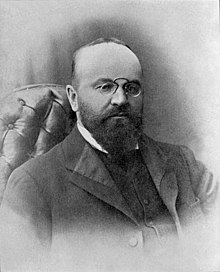Dmitri Wassiljewitsch Sirotkin
Dmitry Vasilyevich Sirotkin ( Russian Дмитрий Васильевич Сироткин ; born May 10 . Jul / 22. May 1864 greg. In the village Ostapowo at Balachna ; † 13. July 1953 in Belgrade ) was a Russian ship owner and patron .
Life
Sirotkin came from a traditional peasant family. Sirotkin's father traded in carvings and then bought two small steamers . In his youth, Sirotkin worked as a cook on the Volga ship .
In 1890 Sirotkin married the daughter of the Kazan merchant and shipowner Kusma Sidorowitsch Tschetwergov, with whose help he bought his first tug in 1895 . Then he acquired the oil transport company CM Shibayev with four tugs. In 1907 the industrial trade and steamship company Dmitri Wassiljewitsch Sirotkin was established with a capital of 1.5 million rubles , which owned 15 steamers and about 50 ships without a steam engine . In 1910 he became director and managing director of the Volga shipping company .
From 1907 Sirotkin was chairman of the Nizhny Novgorod Stock Exchange Committee and from 1908 chairman of the Council of Congresses of Shipowners of the Volga Basin. In 1913 he became chairman of the Po Wolge steamship company . He bought a plot of land in Nizhny Novgorod on Minin and Poscharsky Square for the shipping company's administration building and commissioned the architect Leonid Alexandrovich Wesnin to build it (the building is now used by the Nizhny Novgorod State Medical Academy).
Since 1899, Sirotkin Chairman of the Council of Congresses was the all-Russian Old Believers of Belokriniza - hierarchy . In 1902 Sirotkin suggested to Maxim Gorky that a day care center be set up for the unemployed. With funding from the city duma and the patron Nikolai Alexandrowitsch Bugrow , a tea club for the poor was set up in the house built by the architect Georg Ivanovich Kiesewetter from 1838–1840 for the head of the city, called The Columns . When Sirotkin advocated strengthening the rights of the laity in the Church in 1908, he got into a dispute with the orthodox, old ritualistic bishop of Nizhny Novgorod and Kostroma Innokenti. In September 1910, the community assembly forced him to give up his office as chairman. He then resigned as chairman of the Council of Congresses of All-Russian Old Believers of the Belokrinitsa hierarchy, whereupon the majority of the delegates of the 10th Congress asked him to stay. Sirotkin financed the construction of the Church of the Old Believers in his home village in 1913 according to the plans of the Wesnin brothers. He donated for the church magazine, and the Nizhny Novgorod parish lived on his donations. The house of prayer was also assigned to him.
In March 1913 Sirotkin was elected head of the Nizhny Novgorod city with a four-year term. He waived the main city salary. When a prayer service with the newly ordained priests took place in May 1913 on the occasion of the 300th anniversary of the Romanovs' throne , the old believing Sirotkin was demonstratively not crucified . During his tenure, the first central sewer system was built in Nizhny Novgorod with funding from Nikolai Alexandrovich Bugrov . The city took over the tram and the electricity industry. A city bakery was opened. In 1916 Sirotkin participated in the opening of the People's University . In February 1917, during the February Revolution , Sirotkin was re-elected head of the city. In September 1917 he was replaced by the Provisional Government . In the autumn of 1917 he was sent by the Union of Old Believers to the Provisional Council of the Republic. In November 1917, he ran unsuccessfully on the list of Old Believers for the Russian Constituent Assembly .
In 1917 Sirotkin built a poor house with a church for the Old Believers in memory of his mother and supported the church choir .
After the October Revolution , Sirotkin lived in the White South, mainly in Rostov-on-Don , and played an important role in business circles. At the end of 1919 he traveled to France . He then settled with his family in Yugoslavia and lived on the income from the operation of two small steamers.
On May 25, 2011, a monument to Sirotkin was inaugurated on Sirotkin's grave in Belgrade cemetery, which was commissioned by the Nizhny Novgorod administration in early 2011 based on the design of the architect Soja Ryurikova with funding from the Nizhny Novgorod shipbuilding company SNT founded by Sirotkin . In 2012, a monument with Sirotkin's bust by the sculptor Viktor Ivanovich Purichov was erected on the banks of the Volga across from his previous villa in Nizhny Novgorod .
Individual evidence
- ↑ Арсеньев А. Б., Нехотин В. В .: Новое о Д. В. Сироткине . In: Родина . tape 11 , 1998, pp. 87-95 ( [1] [accessed November 13, 2019]).
- ↑ a b c d e f g Russkaja Wera: Дмитрий Васильевич Сироткин (1865–13 июля 1953) (accessed November 12, 2019).
- ↑ Селезнев Ф. А .: Д. В. Сироткин и всероссийские съезды старообрядцев в начале XX века . In: Отечественная история . No. 5 , 2005, p. 78-90 .
- ↑ Памятник известному старообрядцу Дмитрию Сироткину установлен в столице Сербии (accessed November 13, 2019).
| personal data | |
|---|---|
| SURNAME | Sirotkin, Dmitri Wassiljewitsch |
| ALTERNATIVE NAMES | Сироткин, Дмитрий Васильеви (Russian) |
| BRIEF DESCRIPTION | Russian shipowner and patron |
| DATE OF BIRTH | May 22, 1864 |
| PLACE OF BIRTH | Ostapowo near Balachna |
| DATE OF DEATH | July 13, 1953 |
| Place of death | Belgrade |


